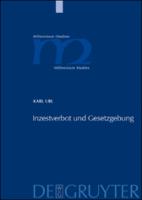Inzestverbot und Gesetzgebung
Die Konstruktion eines Verbrechens (300-1100)
| dc.contributor.author | Ubl, Karl | |
| dc.date.accessioned | 2021-12-07T16:16:23Z | |
| dc.date.available | 2021-12-07T16:16:23Z | |
| dc.date.issued | 2008 | |
| dc.identifier | ONIX_20211207_9783110210682_89 | |
| dc.identifier | OCN: 423072989 | |
| dc.identifier.issn | 1862-1139 | |
| dc.identifier.uri | https://library.oapen.org/handle/20.500.12657/51734 | |
| dc.language | German | |
| dc.relation.ispartofseries | Millennium-Studien / Millennium Studies | |
| dc.subject.classification | thema EDItEUR::N History and Archaeology::NH History::NHC Ancient history | en_US |
| dc.subject.classification | thema EDItEUR::N History and Archaeology | en_US |
| dc.subject.classification | thema EDItEUR::3 Time period qualifiers::3K CE period up to c 1500 | en_US |
| dc.subject.classification | thema EDItEUR::J Society and Social Sciences::JP Politics and government::JPH Political structure and processes::JPHC Constitution: government and the state | en_US |
| dc.subject.other | Middle Ages | |
| dc.subject.other | Late Antiquity | |
| dc.subject.other | Christianity | |
| dc.subject.other | History of Law | |
| dc.subject.other | Incest Taboo | |
| dc.title | Inzestverbot und Gesetzgebung | |
| dc.title.alternative | Die Konstruktion eines Verbrechens (300-1100) | |
| dc.type | book | |
| oapen.abstract.otherlanguage | From the 6th to 11th centuries, the prohibition of marriage between relatives (incest) often headed the agenda of legislative assemblies and can be seen as a key topic of this age. The reasons for this unique development have occupied ethnologists, sociologists and historians for quite some time. This book is the first to trace the radical expansion of marriage prohibitions across epochs and advances the thesis that this development came about as a result of the decline of power in Antiquity and the changing functions of legislation. | |
| oapen.identifier.doi | 10.1515/9783110210682 | |
| oapen.relation.isPublishedBy | 2b386f62-fc18-4108-bcf1-ade3ed4cf2f3 | |
| oapen.relation.isbn | 9783110210682 | |
| oapen.relation.isbn | 9783110202960 | |
| oapen.series.number | 20 | |
| oapen.pages | 591 | |
| oapen.place.publication | Berlin/Boston |

